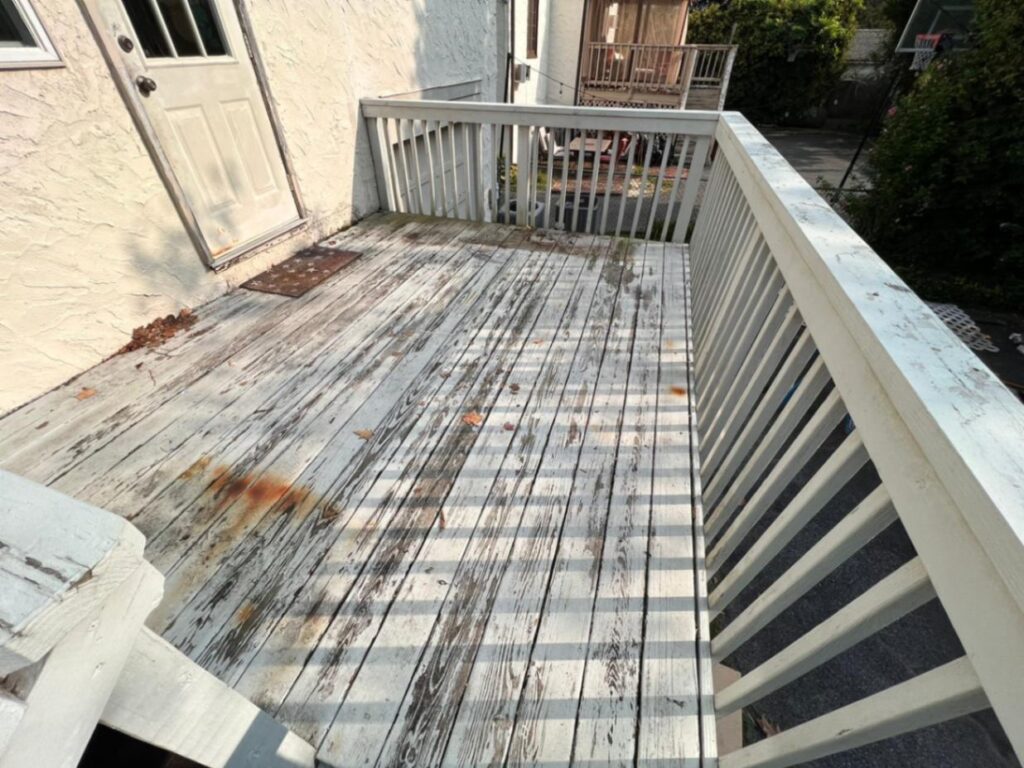Your deck is an essential part of your outdoor space, but it can face several common problems that need addressing. From rotting wood to loose boards, these issues can escalate quickly if left unattended. Regular maintenance is key, and knowing how to tackle each problem can save you time and money. Let's explore the most frequent deck issues and practical solutions to keep your outdoor area safe and appealing. When moisture penetrates your deck, it often leads to rotting wood, a common problem that can compromise the integrity of your structure. Excessive wood moisture creates an ideal environment for decay and pest infestation, such as termites and carpenter ants. To prevent this, regularly inspect your deck for signs of water damage and address any issues promptly. Confirm proper drainage and consider applying a waterproof sealant to protect the wood. If you discover rotting boards, it's essential to replace them immediately, as compromised wood can lead to further structural damage. Additionally, check for pest activity and treat infestations as needed to safeguard your deck. Addressing these issues early will help maintain your deck's longevity and safety. Loose boards can create safety hazards on your deck, so addressing them promptly is essential. Start by inspecting the deck for any loose or damaged boards. Tighten screws or nails that have come loose using a power drill or hammer. If a board is severely warped or cracked, it may require board replacement. Measure the dimensions of the affected board and purchase a matching replacement. Remove the old board carefully, ensuring you don't damage surrounding boards. Install the new board using appropriate fasteners for secure attachment. Regular deck maintenance will help prevent future issues, so check for loose boards regularly and make necessary repairs. By staying proactive, you can keep your deck safe and functional for years to come. Although exposure to sun, rain, and temperature fluctuations can lead to faded finishes on your deck, restoring its appearance is a manageable task. Start by cleaning the surface thoroughly with a deck cleaner to remove dirt and debris. Next, choose a suitable stain that matches your deck's original color. Consider using staining techniques like back-brushing to guarantee even coverage. Apply the stain in the direction of the wood grain for the best results. Once the stain dries, explore weatherproofing options, such as sealants, to improve protection against future fading. Regular maintenance, including re-staining every few years, will keep your deck looking fresh and extend its lifespan. With these steps, your deck will regain its vibrant appearance. Mold can quickly become a problem for your deck if moisture is allowed to linger, so taking steps to prevent its growth is vital. Start with proper drainage; guarantee your deck has adequate slope to direct water away. Regularly clean your deck to remove debris and organic material that can retain moisture. For mold prevention, consider applying a sealant specifically designed to resist mold growth. If mold does appear, immediate mold treatment is imperative. Use a mixture of water and mild detergent or a specialized mold remover. Scrub affected areas with a stiff brush, then rinse thoroughly. Always allow your deck to dry completely before sealing or applying any protective coatings to prevent future mold issues. Structural integrity is vital for the safety and longevity of your deck, and identifying weak spots early can save you from costly repairs later. Start by inspecting the deck's support beams for signs of rot or damage, as these are essential for maintaining deck stability. Check for loose or missing fasteners that may compromise structural strength. Look for signs of sagging or uneven surfaces, which could indicate underlying issues. If you find any weak spots, you can reinforce them by adding additional support beams or replacing damaged ones. Regularly monitor your deck for signs of wear and tear, addressing problems promptly to guarantee you maintain a safe and sturdy outdoor space. You should inspect your deck at least twice a year. Frequent deck inspections help identify common deck issues like cracks or rot early, ensuring you can address them before they escalate into costly repairs. For deck maintenance, you'll need basic repair tools like a hammer, screwdriver, and saw, along with deck cleaning supplies such as a pressure washer, brushes, and cleaning solutions to keep your deck in top shape. You can't use regular paint on your deck. Instead, opt for specialized paint types designed for deck materials like wood or composite. These products guarantee better adhesion, durability, and protection against weather-related damage. Yes, it's safe to power wash your deck if you take proper precautions. Use appropriate deck cleaning techniques, adjust the pressure, and maintain a safe distance to avoid damaging the wood or finish. The best time for deck maintenance is spring or fall, considering seasonal maintenance needs. Ascertain temperatures are mild, avoiding extreme weather conditions that can affect sealants and treatments, helping your deck stay in prime condition. By addressing these common deck problems promptly, you can extend the life of your outdoor space and maintain its appeal. Regular inspections and timely repairs can prevent issues like rotting wood, loose boards, and mold growth from escalating. Restore faded finishes and guarantee proper drainage to protect your deck from moisture damage. Stay proactive, and you'll enjoy a safe, beautiful deck for years to come. Don't wait—take action now to keep your deck in top condition.
Key Takeaways
Rotting Wood: Causes and Solutions
Loose Boards: How to Secure Them
Faded Finishes: Restoring Your Deck's Appearance
Mold Growth: Prevention and Treatment
Structural Issues: Identifying and Repairing Weak Spots
Frequently Asked Questions
How Often Should I Inspect My Deck for Problems?
What Tools Do I Need for Deck Maintenance?
Can I Use Regular Paint on My Deck?
Is It Safe to Power Wash My Deck?
When Is the Best Time to Perform Deck Maintenance?
Conclusion